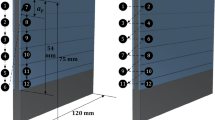Abstract
In-process workpiece elastic deflection is the major source of geometrical error when machining low-stiffness workpieces. It creates an undercut error which needs to be corrected by time-consuming and labour-intensive operations. For this reason, cutting process simulation is growing in interest. To do so, a model representing the workpiece flexibility is coupled with a model to predict the applied cutting forces. For a given tool-material set, these cutting forces depend on the cut section, which therefore depends on current deflection of the part during machining, but also on the level of tool wear. This research work focuses on developing a general coupling approach to tackle this challenge. The case study is the finish turning on thin Inconel 718 discs. The cutting forces are predicted by a mechanistic model taking tool wear into account. The wear effect is expressed using the cumulative removed volume. The workpiece stiffness is determined with a reduced model using a modal basis. When dealing with large workpieces, it results in a remarkable computing time reduction during the time domain simulation. Cutting tests with varying engagements are simulated in a dexel-based versatile framework and undercut errors are compared to experimental observations.










Similar content being viewed by others
Data Availability
No data or material are made available by the authors.
References
Ma J, He G, Liu Z, Qin F, Chen S, Zhao X (2018) Instantaneous cutting-amount planning for machining deformation homogenization based on position-dependent rigidity of thin-walled surface parts. J Manuf Process 34(Part A):401–411
Chen W, Xue J, Tang D, Chen H, Qu S (2009) Deformation prediction and error compensation in multilayer milling processes for thin-walled parts. Int J Mach Tools Manuf 49(11):859–864
Yan Q, Luo M, Tang K (2018) Multi-axis variable depth-of-cut machining of thin-walled workpieces based on the workpiece deflection constraint. Comput Aided Des 100:14–29
Huang T, Zhang X-M, Ding H (2017) Tool orientation optimization for reduction of vibration and deformation in ball-end milling of thin-walled impeller blades. Procedia CIRP 58:210–215
Wang J, Ibaraki S, Matsubara A (2017) A cutting sequence optimization algorithm to reduce the workpiece deformation in thin-wall machining. Precis Eng 50(Supplement C):506–514
Fei J, Xu F, Lin B, Huang T (2020) State of the art in milling process of the flexible workpiece. Int J Adv Manuf Technol 109(5):1695–1725
Dépincé P, Hascoët J-Y (2006) Active integration of tool deflection effects in end milling. Part 2. Compensation of tool deflection. Int J Mach Tools Manuf 46(9):945–956
Dépincé P, Hascoet J-Y (2006) Active integration of tool deflection effects in end milling. Part 1. Prediction of milled surfaces. Int J Mach Tools Manuf 46(9):937–944
Ratchev S, Govender E, Nikov S, Phuah K, Tsiklos G (2003) Force and deflection modelling in milling of low-rigidity complex parts. J Mater Process Technol 143–144:796–801
Bathe K-J (2006) Finite element procedures. Klaus-Jurgen Bathe
Arrazola PJ, Garay A, Fernandez E, Ostolaza K (2014) Correlation between tool flank wear, force signals and surface integrity when turning bars of Inconel 718 in finishing conditions. Int J Mach Mach Mater 15(1–2):84–100
Toubhans B, Fromentin G, Viprey F, Karaouni H, Dorlin T (2020) Machinability of inconel 718 during turning: Cutting force model considering tool wear, influence on surface integrity. J Mater Process Technol:116809
Sawangsri W, Cheng K (2016) An innovative approach to cutting force modelling in diamond turning and its correlation analysis with tool wear. Proc Inst Mech Eng Part B J Eng Manuf 230(3):405–415
Cheng K (2008) Machining dynamics: fundamentals, applications and practices. Springer Science & Business Media
Lee SW, Nestler A (2012) Virtual workpiece: workpiece representation for material removal process. Int J Adv Manuf Technol 58(5–8):443–463
Van Hook T (1986) Real-time shaded NC milling display. ACM SIGGRAPH Comput. Graph
Coffignal G, Lorong P, Illoul L (2015) A general method to accurately simulate material removal in virtual machining of flexible workpieces. Technical Report, PIMM laboratory, 40 pages
Lorong P, Coffignal G, Balmes E, Guskov M, Texier A (2012) Simulation of a finishing operation: milling of a turbine blade and influence of damping. Eng Syst Design Anal 44878:89–98
Code availability
No code are made available by the authors.
Author information
Authors and Affiliations
Contributions
Bastien Toubhans: Conceptualization, methodology, writing—reviewing and editing. Philippe Lorong: Conceptualization, methodology, supervision, validation. Guillaume Fromentin: Conceptualization, methodology, supervision, validation. Fabien Viprey: Conceptualization, methodology, supervision, validation. Habib Karaouni: Validation, resources.
Corresponding author
Ethics declarations
Ethical approval
The authors have read and applied the ethical rules stated in the guidelines for authors.
Consent to participate
Not applicable.
Consent to publish
Not applicable.
Conflict of interest
The authors declare that they have no conflict of interests.
Additional information
Publisher’s note
Springer Nature remains neutral with regard to jurisdictional claims in published maps and institutional affiliations.
Rights and permissions
About this article
Cite this article
Toubhans, B., Lorong, P., Viprey, F. et al. A versatile approach, considering tool wear, to simulate undercut error when turning thin-walled workpieces. Int J Adv Manuf Technol 115, 1919–1929 (2021). https://doi.org/10.1007/s00170-021-07243-8
Received:
Accepted:
Published:
Issue Date:
DOI: https://doi.org/10.1007/s00170-021-07243-8



